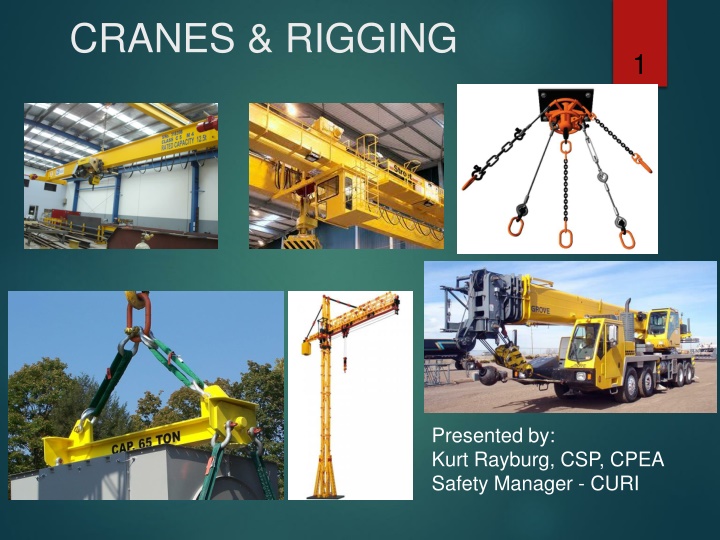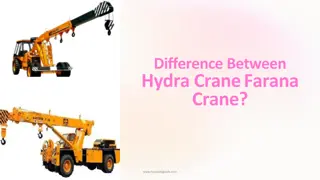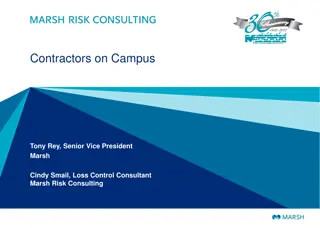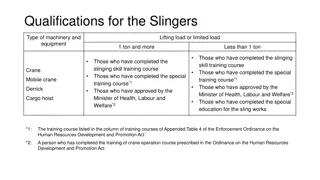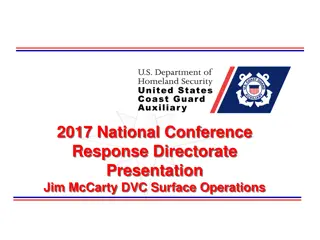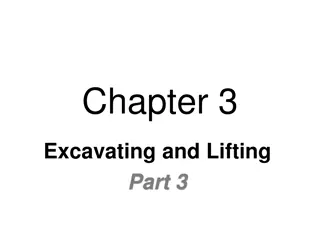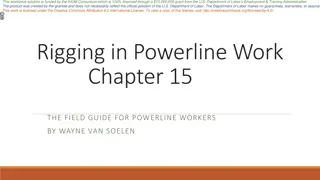Comprehensive Guide to Cranes and Rigging Safety Practices
Explore the world of cranes and rigging with valuable information on terminology, types of cranes, certifications, training requirements, inspections, and operational checks. Learn about the importance of certified operators, qualified personnel, and competent individuals in maintaining a safe work environment. Stay informed on OSHA regulations, deadlines, and best practices to ensure crane safety in the workplace.
Download Presentation

Please find below an Image/Link to download the presentation.
The content on the website is provided AS IS for your information and personal use only. It may not be sold, licensed, or shared on other websites without obtaining consent from the author.If you encounter any issues during the download, it is possible that the publisher has removed the file from their server.
You are allowed to download the files provided on this website for personal or commercial use, subject to the condition that they are used lawfully. All files are the property of their respective owners.
The content on the website is provided AS IS for your information and personal use only. It may not be sold, licensed, or shared on other websites without obtaining consent from the author.
E N D
Presentation Transcript
CRANES & RIGGING 1 Presented by: Kurt Rayburg, CSP, CPEA Safety Manager - CURI
Terminology 2 Crane a machine for lifting and lowering a load and moving it horizontally, with the hoisting mechanism. Cranes are driven manually or by power. Derrick an apparatus consisting of a mast held at the head by guys or braces, with or without a boom, for use with a hoisting mechanism and operating ropes.
Terminology 3 Certified Operator a person who has successfully completed a training curriculum from an accredited crane operator testing program. (Crane Institute/NCCCO) Qualified Person a person who, by possession of a recognized degree, certificate or professional standing, or by extensive training, knowledge and experience, successfully demonstrates the ability to solve or resolve issues related to a subject matter. Competent Person a person who is capable of identifying existing and predictable hazards and has the authority to take corrective action.
Types of Cranes 4 Crawler Gantry Tower Mobile Overhead Jib
Training 7 OSHA has a deadline for crane operators certification to November 10th, 2018. (Construction Standard) Testing agencies must be accredited by a nationally recognized accrediting agency based on criteria for; - Written and practical exams - Testing materials / grading - Facilities and equipment Industrial 1910.179(b)(8) - Only designated personnel shall be permitted to operate a crane.
Crane Inspections 8 Each Shift - Competent person must inspect prior to each shift (use). Monthly Competent person must document monthly inspection and retain for 3 months. Annual - Qualified person must inspect, disassemble and functionally test. Retain document for 1 year *Certification training includes inspection techniques.
Operational Inspection 9 Move crane several feet in each direction Unusual noises and jerky movements Control station and switches work correctly Lower hoist block to make sure at least 2 turns of rope remain on drum Hook has a safety latch and it s not stretched.
Visual Inspection 10 Look for crane tags Look for physical damage Check hoist chain and wire rope Make sure wire rope is seated in drum and sheave grooves Look for disconnect switch.
Rigging What We Need To Know 12 Employers must ensure: 1) inspection prior to use 2) permanent markings are affixed showing safe working load 3) not to be loaded in excess of working load 4) not to be used without affixed markings 5) when not in use, removed from working area
Rigging Considerations 14 POSITIVE CONNECTION 1. ROTATION 2. EQUALIZATION 3. CENTER OF GRAVITY 4.
Rigging Equipment Slings 15 Types of slings covered are those made from alloy steel chain, wire rope, metal mesh, natural or synthetic fiber rope, and synthetic web. Synthetic Wire rope Metal mesh Chain
Alloy Steel Chains 16 Adapts to shape of the load Can be damage by sudden shocks Best choice for hoisting very hot materials Must have an affixed tag stating size, grade, rated capacity, and sling manufacturer
Alloy Steel Chain Attachments Rated Capacity 17 Hooks, rings, oblong links, or other attachments, when used with alloy steel chains, must have a rated capacity at least equal to that of the chain
Unsuitable Alloy Steel Chain Attachments 18 Right Wrong Job or shop hooks and links, or makeshift fasteners, formed from bolts, rods, etc., or other altered attachments, can t be used
Wire Rope Slings 19 Wire Used to hoist materials Selection considerations: Center Core strength ability to bend without cracking ability to withstand abrasive wear ability to withstand abuse Strand Wire rope
Wire Rope Slings Cont. 20 If these happen, remove the wire rope sling from service Kinking Bird Caging Crushing
Wire Rope Clips 21 When using U-bolt wire rope clips to form eyes, ensure the "U" section is in contact with the dead end of the rope This is the correct method
Synthetic Web Sling Markings 22 Mark or code to show: Name or trademark of manufacturer Rated capacities for the type of hitch Type of material
Synthetic Web Slings Fittings 23 Fittings must be: At least as strong as that of the sling Free of sharp edges that could damage the webbing
Synthetic Web Slings - Remove from Service 24 Remove from service if any of these are present: Acid or caustic burns Melting or charring of any part Snags, punctures, tears or cuts Broken or worn stitches Distortion of fittings Heat Damage
Lifting and Moving 25 Make sure hands are clear of potential pinch points No one is positioned between load and another object Slowly raise hoist block to remove slack Slings are fully seated Lift load a few inches to check rigging Lift load high enough to clear obstructions.
Donts 26 Jog controls unnecessarily Use pendant control station to swing jib boom into place Leave suspended load unattended Pass load over people or allow anyone to walk under it. Pull a load Get distracted Allow unused slings or ropes to remain on the hook Leave hoist block low enough to hit someone.
BASIC HITCHES Load Angle Factor 27 60 degree angle 45 degree angle L H 1000 lbs. 1000 lbs. 10 degree angle 30 degree angle 1000 lbs. 1000 lbs.
Calculation vs LAF Table 28 LAF Sling Angle 90 1.000 60 1.155 45 1.414 30 2.000 20 2.924 Danger 10 5.747 5 11.49 L/H = LAF LAF X Load weight = Total Stress Total Stress x Load Weight Distribution = Stress Per Leg
Signalperson 29 Signalperson must be qualified by 3rd party or employer qualified evaluator Qualification requirements are: - know and understand the types of signals used and be competent in their use - have basic understanding of equipment operation and limitations - demonstrate they meet above requirements through written and oral test
Signalperson 30 When signalperson is needed: - the load travel / placement area is not in full view - the view in the direction of travel is obstructed - either operator or load handler determines it is necessary
EXAM QUESTION # 1 32 Under the new crane standard, you must be certified by an accredited program before you are able to use a crane? (Here at CURI) a) Absolutely b) Designated operators can operate cranes in industrial operations c) Experience and past knowledge will exempt the requirement d) Certification cards can be purchased online to show certification
EXAM QUESTION # 1 33 Under the new crane standard, you must be certified by an accredited program before you are able to use a crane? (Here at CURI) a) Absolutely b) Designated operators can operate cranes in industrial operations c) Experience and past knowledge will exempt the requirement d) Certification cards can be purchased online to show certification
EXAM QUESTION # 2 34 Rigging equipment must be inspected how often? a) Prior to each shift b) Once Daily c) prior to use on each shift and as necessary during the use to ensure that it is safe d) Before quitting time
EXAM QUESTION # 2 35 Rigging equipment must be inspected how often? a) Prior to each shift b) Once Daily c) prior to use on each shift and as necessary during the use to ensure that it is safe d) Before quitting time
EXAM QUESTION # 3 36 Who must perform inspections on slings? a) Anyone with knowledge and training b) Only trained supervisors c) A competent person d) Only iron workers
EXAM QUESTION # 3 37 Who must perform inspections on slings? a) Anyone with knowledge and training b) Only trained supervisors c) A competent person d) Only iron workers
EXAM QUESTION # 4 38 When using U-bolt wire rope clips to form eyes, ensure the "U" section is in contact with the __________ of the rope? a) Live end b) Dead end c) Both ends d) No ends
EXAM QUESTION # 4 39 When using U-bolt wire rope clips to form eyes, ensure the "U" section is in contact with the __________ of the rope? a) Live end b) Dead end c) Both ends d) No ends
EXAM QUESTION # 5 40 Operators using cranes, derricks and chain falls < 1 ton need not to be trained in the proper operation and hazards? a) True b) False
EXAM QUESTION # 5 41 Operators using cranes, derricks and chain falls < 1 ton need not to be trained in the proper operation and hazards? a) True b) False
EXAM QUESTION # 6 42 A signalperson is needed when the load placement location is obstructed or not in full view? a) True b) False
EXAM QUESTION # 6 43 A signalperson is needed when the load placement location is obstructed or not in full view? a) True b) False
44 QUESTIONS?
